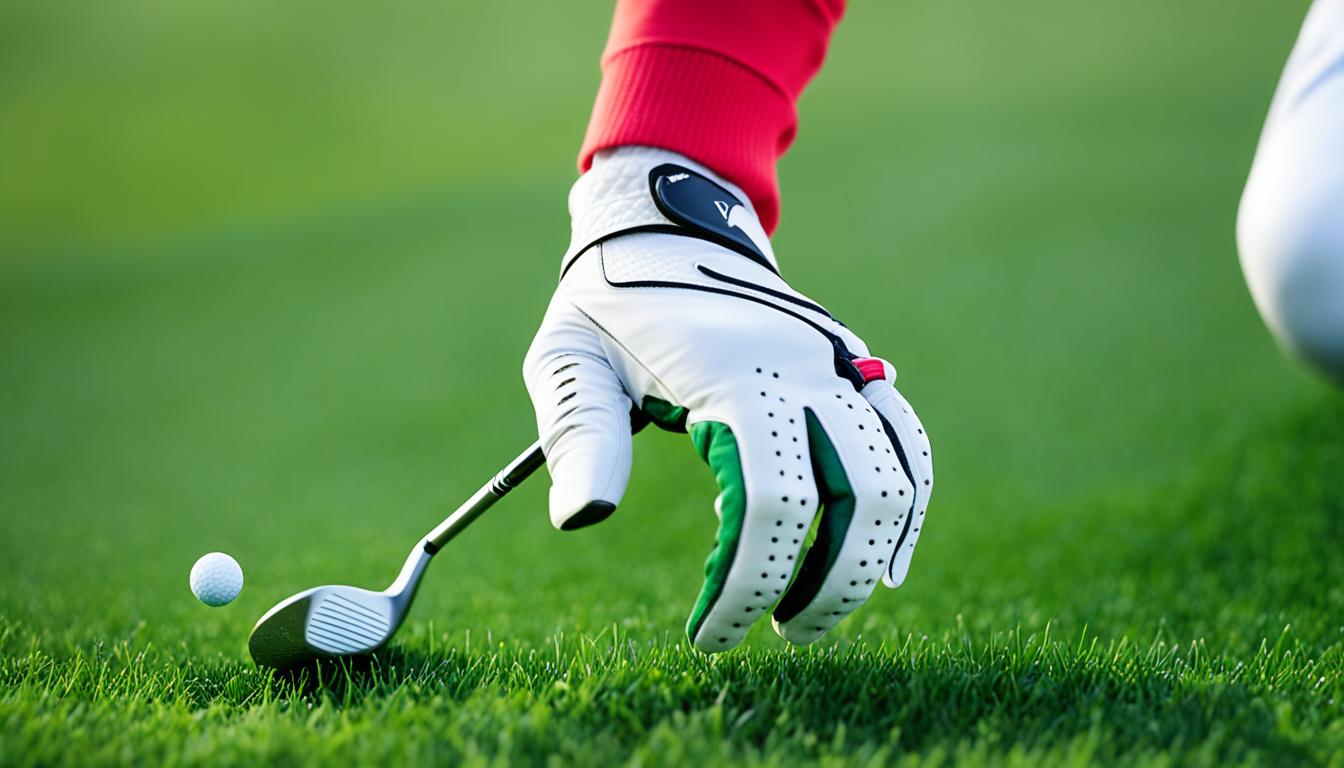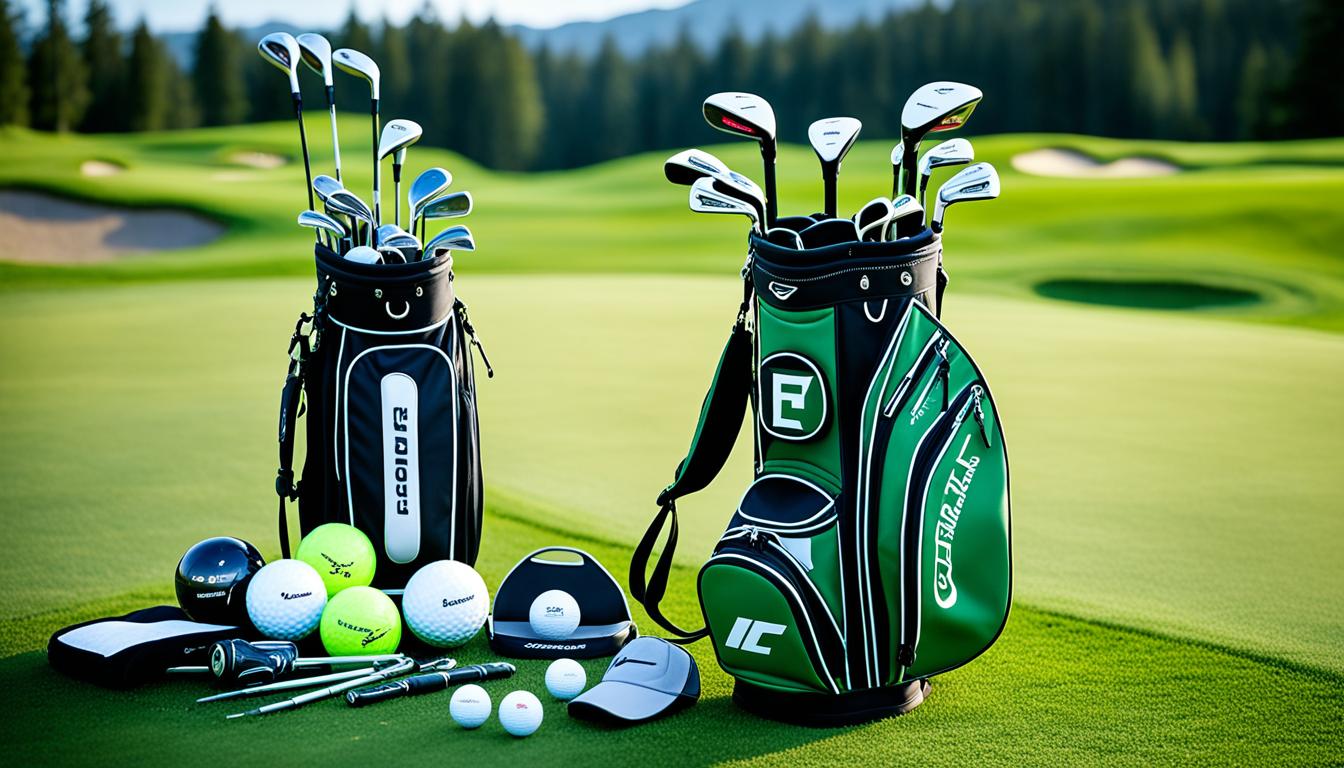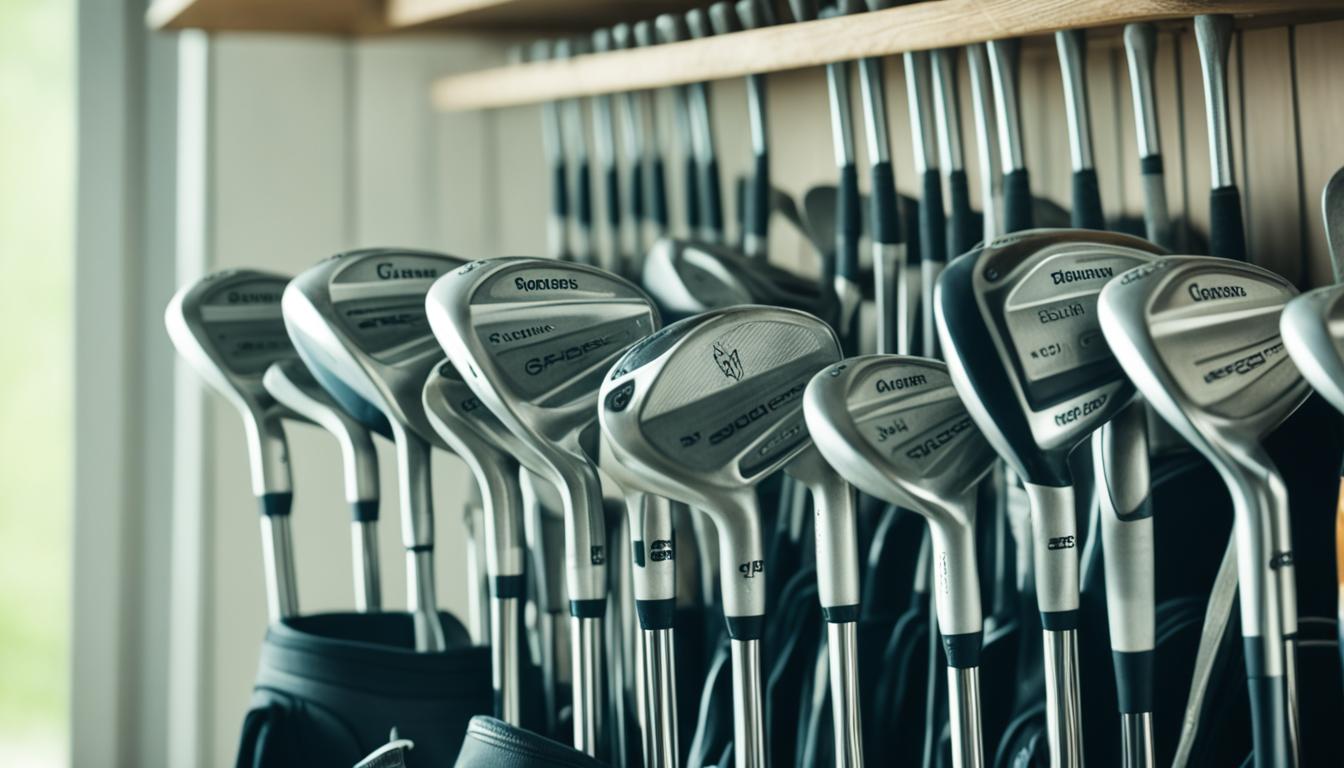Golf gloves play a crucial role in enhancing a golfer’s grip and overall performance on the green. They provide numerous benefits, including improved grip, reduced hand fatigue, and protection against blisters and calluses. Choosing the right golf glove involves considering factors such as size, material, and style. By using the right golf glove, golfers can enhance their performance and enjoy a more effective and enjoyable game on the course.
Key Takeaways:
- Golf gloves are essential for enhancing grip and performance in golf.
- They offer improved grip, reduced hand fatigue, and protection against blisters and calluses.
- Choosing the right golf glove involves considering factors like size, material, and style.
- Golfers can enhance their performance by using the right golf glove.
- Proper care and maintenance of golf gloves can prolong their lifespan and maximize their effectiveness.
Understanding the Importance of Golf Gloves
Golf gloves are not just stylish accessories; they are essential tools for golfers of all skill levels. The right golf glove can significantly enhance a golfer’s grip on the club, reducing the risk of slippage during swings. Additionally, golf gloves provide comfort, reduce hand fatigue, and protect against blisters and calluses. The improved grip and added comfort that golf gloves provide contribute to overall better performance on the course.
Benefits of Using Golf Gloves
Using golf gloves offers several key benefits:
- Improved Grip: Golf gloves are designed with materials that provide enhanced traction and grip on the club. This improves control and accuracy during swings, leading to better shots and overall performance on the green.
- Reduced Hand Fatigue: The padding and cushioning in golf gloves help absorb shock and mitigate the impact on the hands, reducing fatigue during prolonged play. This allows golfers to maintain a firm grip throughout their game without discomfort or strain.
- Protection against Blisters and Calluses: The repetitive motion of gripping the club can cause friction and irritation, leading to blisters and calluses. Golf gloves act as a barrier, protecting the hands and preventing these common golfing ailments.
The benefits of using golf gloves go beyond just grip improvement. They provide added comfort and protection, allowing golfers to focus on their swings and perform at their best.
Choosing the Right Golf Glove
When selecting a golf glove, there are a few factors to consider:
- Size: It’s crucial to choose a golf glove that fits snugly but allows for flexibility. A glove that is too tight can restrict movement, while one that is too loose may compromise grip.
- Material: Golf gloves are typically made from leather or synthetic materials. Leather gloves are known for their premium feel, durability, and breathability. Synthetic gloves are more affordable and offer excellent grip in various weather conditions. The choice between the two depends on personal preference and playing requirements.
- Style: Golf gloves come in full-fingered and half-fingered variations. Full-fingered gloves provide more coverage and protection, while half-fingered gloves offer increased breathability and flexibility. The preferred style depends on individual comfort and playing conditions.
Choosing the right golf glove ensures a proper fit and maximizes the benefits it provides.
| Glove Type | Material | Advantages |
|---|---|---|
| Leather Gloves | Genuine leather | Durable, premium feel, breathable |
| Synthetic Gloves | Synthetic materials | Affordable, excellent grip in various weather conditions, easy to maintain |
| All-Weather Gloves | Blend of materials | Versatile for use in wet and dry conditions |
Table: Comparison of Different Types of Golf Gloves
Proper care and maintenance of golf gloves are essential for prolonging their lifespan. Golfers should wipe down their gloves after each round to remove dirt and sweat. It’s also important to store golf gloves in a cool, dry place to prevent damage. Rotating between multiple gloves can help extend their lifespan. By following these care and maintenance tips, golfers can ensure that their golf gloves remain in good condition and continue to provide optimal grip and performance.
Choosing the Right Golf Glove
When it comes to improving your golf game, choosing the right golf glove is essential. The right glove can make a significant difference in your performance on the green, providing you with better grip and comfort during swings. Here are some factors to consider when selecting your golf glove:
Size: The size of your golf glove should be snug but not too tight. A glove that is too small can restrict movement, while a glove that is too big may cause slippage. Finding the right size ensures flexibility and comfort while maintaining a secure grip on the club.
Material: Golf gloves come in different materials, with leather and synthetic options being the most common. Leather gloves offer a premium feel and tend to be more durable, however, they can be more expensive. Synthetic gloves, on the other hand, are more affordable, easy to maintain, and often provide excellent grip in various weather conditions. Consider your budget and desired performance when choosing the material of your golf glove.
Finger Style: Golf gloves are available in both full-fingered and half-fingered styles. Full-fingered gloves provide complete coverage and protection for your hands, while half-fingered gloves offer better breathability and flexibility. The choice between the two depends on personal preference and the playing conditions you typically encounter.
By taking these factors into account and selecting the right golf glove, you can maximize the benefits it provides. Take a look at the table below for a quick comparison of the different factors to consider:
| Factors to Consider | Leather Gloves | Synthetic Gloves | Full-fingered Gloves | Half-fingered Gloves |
|---|---|---|---|---|
| Material | Genuine leather | Synthetic materials | Various materials | Various materials |
| Durability | High | Moderate | Varies | Varies |
| Grip | Good | Excellent | Varies | Varies |
| Budget | Higher cost | Affordable | Varies | Varies |
| Main Advantage | Premium feel and durability | Affordability and grip | Complete hand coverage | Better breathability and flexibility |
Remember, choosing the right golf glove is an important step in improving your golf game. Whether you prefer leather or synthetic, full-fingered or half-fingered, finding the glove that suits your needs will enhance your performance on the green. Now that you’ve learned about choosing the right golf glove, let’s move on to exploring the different types of golf gloves available.
Types of Golf Gloves
Golf gloves come in various types to cater to different golfer’s needs. Each type offers its own unique advantages, allowing golfers to choose the gloves that best suit their preferences and playing conditions. Let’s explore the different types of golf gloves:
1. Leather Gloves
Leather gloves are highly regarded for their premium feel, exceptional durability, and superior grip. Crafted from high-quality leather, these gloves provide a luxurious fit and excellent control over the club. They are a popular choice among serious golfers who prioritize performance and comfort. Leather gloves offer a timeless style that elevates any golfer’s game.
2. Synthetic Gloves
Synthetic gloves are an excellent choice for golfers looking for affordability, ease of maintenance, and reliable grip. Made from synthetic materials such as microfiber or synthetic leather, these gloves offer enhanced breathability, moisture-wicking properties, and a secure fit. Synthetic gloves are designed to provide excellent grip in various weather conditions, ensuring optimal performance on the green.
3. All-Weather Gloves
All-weather gloves are specifically engineered to perform well in both wet and dry conditions, making them versatile for year-round use. These gloves feature advanced materials that provide a firm grip even in rainy or humid weather. All-weather gloves are designed with enhanced breathability and moisture management technology, keeping the golfer’s hands dry and comfortable throughout the game.
Choosing the right type of golf glove depends on personal preference, playing style, and weather conditions. Some golfers may prefer the traditional feel and durability of leather gloves, while others may prioritize affordability and versatility with synthetic or all-weather gloves. It’s essential to consider these factors when selecting the ideal glove for enhanced grip and performance on the green.
| Type of Golf Glove | Advantages |
|---|---|
| Leather Gloves | Premium feel, durability, superior grip |
| Synthetic Gloves | Affordable, easy to maintain, grip in various weather conditions |
| All-Weather Gloves | Perform well in wet and dry conditions, versatile year-round use |
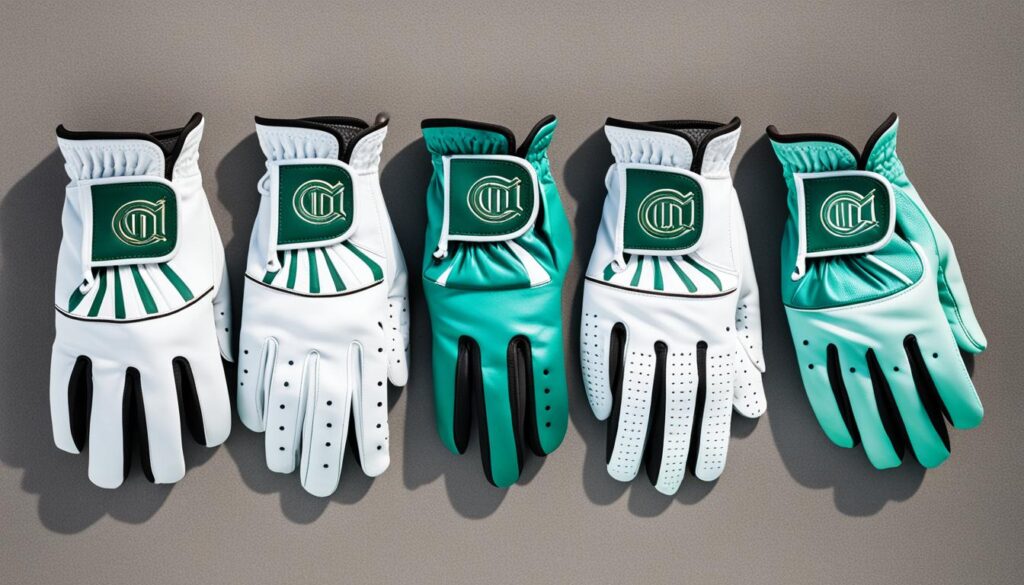
Now that we have explored the different types of golf gloves, we can move on to understanding how to properly care for and maintain these essential accessories. By taking good care of your golf gloves, you can ensure their longevity and continue to enjoy their performance-enhancing benefits on the course.
Proper Care and Maintenance of Golf Gloves
Proper care and maintenance of golf gloves are essential to ensure their longevity and performance. With regular cleaning and storage, you can keep your golf gloves in top condition, providing you with optimal grip and comfort on the green.
After each round, it’s important to wipe down your golf gloves to remove dirt and sweat. This simple task helps maintain the integrity of the material and prevents any buildup that may affect grip. By taking a few minutes to clean your gloves, you’ll ensure they remain fresh and ready for your next game.
Cleaning Method:
- Fill a bowl with lukewarm water and add a small amount of mild detergent.
- Submerge your gloves in the soapy water and gently rub the surfaces to remove dirt and stains.
- Rinse the gloves thoroughly with clean water to remove any soap residue.
- Gently squeeze out excess water without twisting or wringing the gloves.
- Place the gloves on a clean towel and pat them dry. Avoid exposure to direct sunlight or heat sources that could cause shrinkage or damage.
Proper storage is equally important in maintaining your golf gloves’ condition. To prevent any unnecessary wear and tear, store your gloves in a cool, dry place away from direct sunlight. Avoid placing them in a cramped and damp environment, as it can lead to mold or mildew growth.
Storage Tips:
- Avoid leaving your gloves inside your golf bag between rounds, as the lack of proper airflow can encourage moisture buildup.
- Consider investing in a glove holder or clip to keep your gloves organized and well-ventilated.
- Rotate between multiple pairs of gloves to extend their lifespan. This practice allows each pair to fully dry out before their next use.
By following these simple care and maintenance practices, you can maximize the lifespan of your golf gloves and ensure consistent grip and performance. Take the time to clean and store your gloves properly, and they will continue to be your reliable partner on the green.
Up next, we’ll explore the future of golf gloves and the exciting innovations on the horizon. Stay tuned!
The Future of Golf Gloves
The future of golf gloves is an exciting realm of innovation and advancement. As manufacturers continue to push the boundaries, we can expect to see a new generation of golf gloves that offer enhanced grip and performance on the green. These innovative designs and technologies are set to revolutionize the way golfers play and elevate their overall experience.
Manufacturers are constantly striving to improve the materials, construction, and design of golf gloves. With cutting-edge advancements, these gloves will provide golfers with the ultimate combination of comfort, durability, and performance. The future golf gloves will be tailored to meet the specific needs of golfers, allowing for a personalized and optimized playing experience.
One area of focus for future golf gloves is comfort. Golfers can look forward to gloves that provide a second-skin fit, enhancing feel and touch. These gloves will offer maximum breathability, moisture-wicking properties, and adjustable closures for a snug and comfortable fit throughout the game.
Durability will also be a key consideration in the future of golf gloves. Manufacturers will introduce materials and construction techniques that prolong the lifespan of the gloves, ensuring they can withstand the demands of regular use. Golfers can say goodbye to worn-out and frayed gloves, as the future brings gloves that maintain their integrity and performance for longer periods.
Furthermore, the future of golf gloves will see improvements in overall performance. Advanced grip technologies will be integrated into the gloves, providing golfers with a superior hold on the club. These innovations will enhance accuracy and control, allowing golfers to execute their swings with confidence and precision.
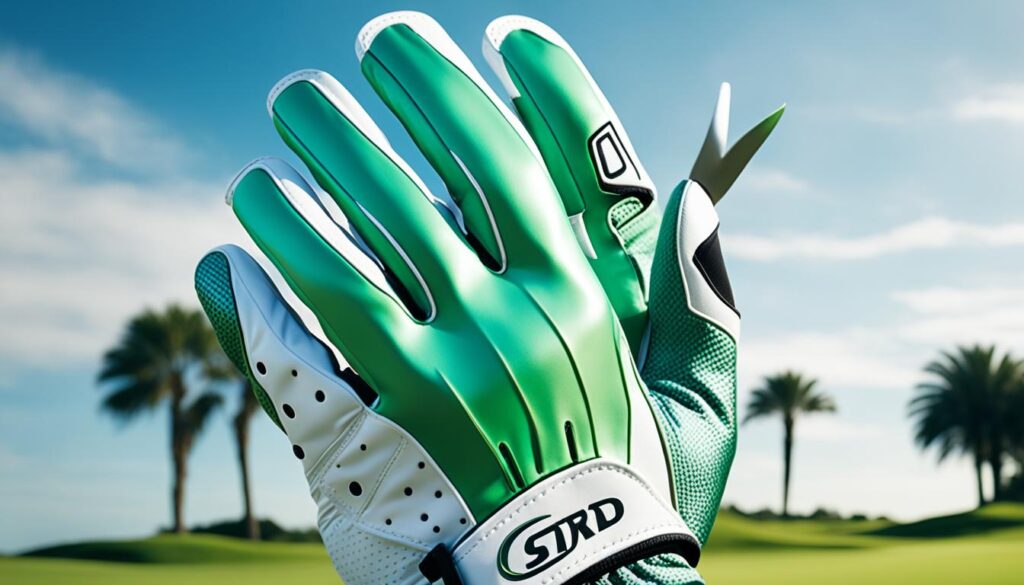
Innovative Golf Glove Technologies
Golfers can expect to see the following innovative technologies in the future of golf gloves:
- Smart fabrics that adapt to different weather conditions, providing optimal grip and feel in any climate.
- Embedded sensors that provide real-time feedback on grip pressure and swing dynamics to help golfers improve their technique.
- Advanced moisture management systems that keep the hands dry, preventing slippage and discomfort during play.
- Intelligent materials that conform to the shape of the hand for a custom fit and improved overall performance.
With these exciting developments on the horizon, the future of golf gloves holds great promise. As golfers embrace these innovative designs and technologies, they can expect to elevate their game to new heights. The future of golf gloves will undoubtedly enhance grip, comfort, durability, and overall performance on the green, providing golfers with an unforgettable playing experience.
Conclusion
Incorporating golf gloves into your game can greatly enhance your grip and overall performance on the green. By choosing the right golf glove and properly maintaining it, you can experience a range of benefits that contribute to a more effective and enjoyable golfing experience.
The use of golf gloves provides an improved grip, allowing for better control over the club and minimizing the risk of slippage during swings. This enhanced grip translates into more accurate shots and increased shot consistency, ultimately leading to better performance on the course.
In addition to grip improvement, golf gloves also reduce hand fatigue and provide protection against blisters and calluses. The padding and materials used in golf gloves offer cushioning and prevent friction, ensuring that you can play comfortably for longer periods without discomfort or pain.
Looking towards the future, continuous innovation in golf glove technology promises even greater comfort, durability, and performance enhancement. Manufacturers are constantly exploring new materials, designs, and construction techniques to further optimize the benefits that golf gloves provide. As golfers embrace these advancements, they can expect further improvements in grip, comfort, and overall golf performance.
So, whether you are a beginner or a seasoned golfer, investing in a high-quality golf glove and incorporating it into your game can make a significant difference. With improved grip, reduced hand fatigue, and protection against blisters, golf gloves undoubtedly play a crucial role in enhancing your golfing experience. So gear up, grab your golf gloves, and enjoy the game with confidence and performance-enhancing benefits.
FAQ
Why are golf gloves important?
Golf gloves are important because they enhance a golfer’s grip on the club, reducing the risk of slippage during swings. They also provide comfort, reduce hand fatigue, and protect against blisters and calluses.
How do golf gloves improve play?
Golf gloves improve play by enhancing grip, reducing hand fatigue, and providing protection against blisters and calluses. With improved grip and added comfort, golfers can perform better on the course.
What factors should I consider when choosing golf gloves?
When choosing golf gloves, consider factors such as size, material, and style. The glove should fit snugly but not be too tight, allowing for flexibility during swings. You can choose between leather and synthetic materials based on your budget and desired performance. Full-fingered or half-fingered gloves can be selected based on personal preference and playing conditions.
What types of golf gloves are available?
There are various types of golf gloves available. Leather gloves are known for their premium feel and durability. Synthetic gloves are affordable, easy to maintain, and offer excellent grip in different weather conditions. All-weather gloves are designed to perform well in wet and dry conditions.
How should I care for and maintain my golf gloves?
To care for and maintain your golf gloves, regularly wipe them down after each round to remove dirt and sweat. Store them in a cool, dry place to prevent damage. It’s also recommended to have multiple gloves in rotation to extend their lifespan.
What does the future hold for golf gloves?
The future of golf gloves includes continuous innovation in materials, construction, and design. Manufacturers are constantly striving to improve comfort, durability, and overall performance. Expect enhanced grip and performance on the green as these advancements are embraced.
How do golf gloves benefit golfers?
Golf gloves benefit golfers by enhancing grip, reducing hand fatigue, and providing protection. With improved grip, golfers can achieve better control over the club and make more accurate swings. Reduced hand fatigue allows for longer, more enjoyable rounds. Protection against blisters and calluses ensures comfort throughout the game.
